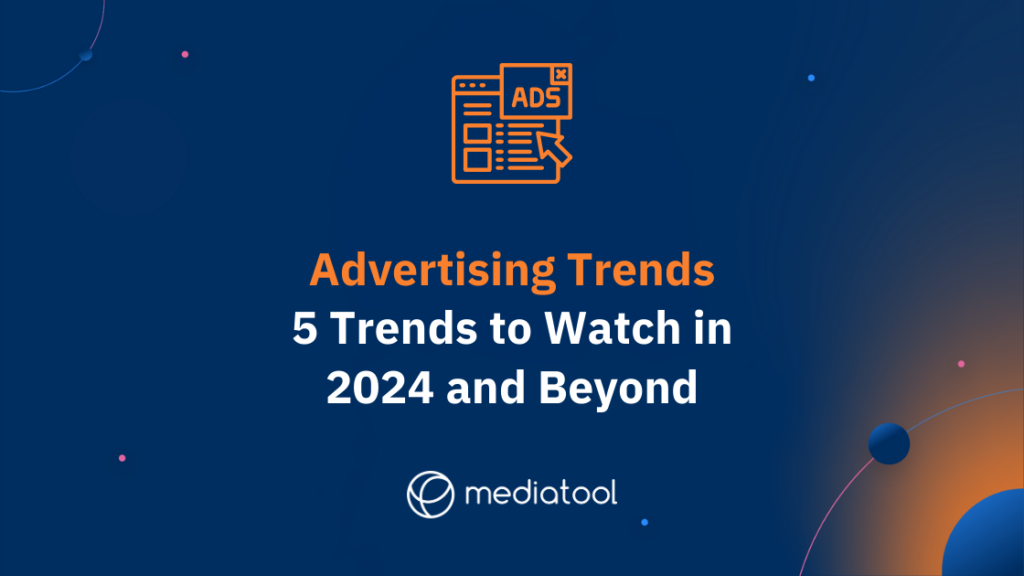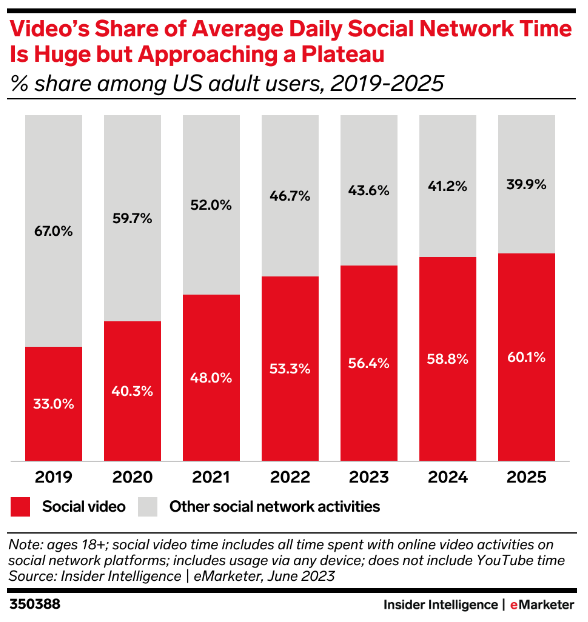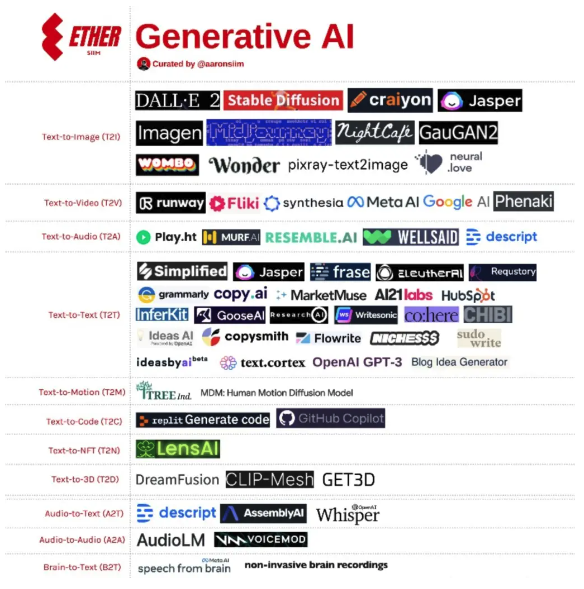Experience is Everything: Advertising Trends in 2024 to Incorporate into Your Strategy
This guide summarizes the 2024 advertising trends to look out for to boost your business.
What will the digital advertising landscape look like in 2024? With the development of technology and consumer behavior, it’s anyone’s guess what shapes digital advertising trends in the coming years.
As the effects of the pandemic are in the rearview, businesses are looking for innovative ways to stay competitive. Digital advertising spending levels are on the rise year over year. Recent data suggests it’s steadily increasing and expected to speed up over the next few years.
Businesses are now exploring new opportunities to engage with customers and promote their products or services while spending cautiously.
Because of the uncertain economic climate, advertising will look a little different in 2024 and the years that follow. Businesses will likely be conservative with advertising expenses, and marketers must be agile, efficient, and creative to stay competitive.
With the rise of digital media and changing consumer behavior, the digital advertising landscape is changing fast. Businesses must stay adaptable and informed of the ongoing advertising trends to make the most of their budget and stay ahead of the competition.
To help stay ahead of the curve, here are five digital advertising trends in 2024 and beyond:
1. Authenticity Will Matter Most on Social Media
In the evolving landscape of digital marketing, particularly post-pandemic, consumers are gravitating towards brands that exhibit genuineness and relatability.
As they navigate the path to financial recovery, their inclination is towards trusted brands, reducing experimentation with new entrants. This trend underscores the significance of authenticity in advertising trends and influencer marketing.
The Impact of Social Media Platforms on Brand Perception
The central role of social media platforms in contemporary advertising cannot be overstated. With over 61% of the global population engaged on these platforms as of October 2023, the influence of social media marketing is immense.
This surge highlights the pivotal role of social media users in shaping brand perceptions and the necessity for brands to adopt a customer-centric approach.
Influencer Marketing: Engaging the Gen Z Audience
The rise of influencers, especially in engaging the Gen Z audience, marks a shift in online advertising trends. Influencers, often more relatable than traditional celebrities, wield considerable sway in fostering brand loyalty through authentic storytelling.
Brands should strategically leverage user-generated content and collaborate with both macro and micro-influencers. This approach in influencer marketing hub activities is crucial in building a genuine connection with the target audience.
Technological Advancements in Digital Advertising
Digital advertising trends also suggest an increasing focus on video ads, particularly short-form video ads, reflecting the preferences of mobile device users.
The integration of artificial intelligence and augmented reality in advertising efforts is redefining engagement strategies in the digital space, offering immersive experiences to consumers.
Optimizing Ad Spend and Enhancing Engagement
Ad spend in digital advertising is increasingly directed towards platforms where the target audiences are most active, including various social platforms and mobile gaming. Marketers are also harnessing AI tools to analyze consumer data and optimize advertising dollars.
The shift towards more interactive formats like conversational marketing and the use of virtual reality in campaigns are part of the broader trend in digital marketing strategy. These techniques are instrumental in enhancing customer engagement and, ultimately, fostering customer loyalty.
As we move into 2024, the emphasis on authenticity, coupled with the right digital marketing strategies and marketing campaigns, is key for brands to maintain relevance and increase sales. The incorporation of new technologies like voice search, machine learning, and augmented reality in advertising represents the next frontier in engaging users and shaping consumer behavior.
2. Visuals Reign Supreme
In the fast-paced digital era, with decreasing attention spans, the impact of visual content in advertising has become more pronounced than ever. This trend is particularly noticeable in video advertising trends, where video content is a key player in engaging customers quickly and effectively.
With an average attention span of just 8 seconds among consumers, a captivating visual is vital in seizing their attention.
The Power of Short-Form Video Content
Video content, especially short-form videos, has emerged as an optimal tool in digital marketing strategies, blending information with entertainment. These visuals are not only engaging but also evoke emotions, enhancing brand recall. High-quality, well-crafted visuals are essential for businesses to make an impression swiftly.
A Resurgence in Long-Form Video Content
The growing interest in long-form video content offers a potential triple win for platforms, advertisers, and creators, promising increased viewer engagement, more ad space, and better revenue sharing. This trend caters to audiences seeking deeper, narrative-driven content, with platforms like YouTube and traditional e-commerce channels becoming ideal hosts for such detailed storytelling.
In 2024, users will spend approximately 58.8% of their time on social platforms, consuming video content.
Insider Intelligence | eMarketer
However, this shift faces challenges. Past attempts by platforms like TikTok and Facebook to promote longer videos have had mixed success, highlighting consumers’ persistent preference for short-form content.
Additionally, creators accustomed to short videos may face a learning curve in adapting to longer formats. With viewers nearing saturation in social video consumption, balancing these elements with audience preferences is crucial for the successful integration of long-form content in the digital landscape.
Embracing New Technologies in Visual Marketing
The rise in ad spending on visual marketing, including innovative interactive experiences like augmented and virtual reality, reflects the shift towards more immersive customer experiences. These technologies allow customers to engage deeply with products and services, enhancing the customer experience and potentially leading to increased sales.
The Evolving Landscape of Video Platforms
Platforms like YouTube continue to lead as the biggest social media platform for visual content, but the rapid growth of TikTok is challenging this dominance. Meanwhile, platforms like Instagram and Snapchat maintain their relevance in the realm of social media marketing.
In this competitive landscape, businesses must diversify their content across various social platforms and leverage user-generated content to amplify their reach and engage their target audience.
3. Artificial Intelligence Shapes Strategies
Artificial intelligence and machine learning have become increasingly important in the world of digital advertising. By 2027, the AI market is forecast to hit a whopping $407 billion, growing by 36.2% CAGR between 2022 and 2027.
Even the tech juggernaut Google isn’t safe from the AI takeover, as Gmail creator Paul Buchheit predicts AI will cause a “total disruption” of the search giant in as little as a year or two.
AI has become integral to any digital marketing strategy, allowing marketers to automate tasks, save time, and maximize ad spend. AI-powered tools can now target customers based on their browsing habits and interests, allowing marketers to personalize ads and create more effective ad campaigns.
From ad targeting to customer segmentation, artificial intelligence is used in more aspects of digital advertising, where data-driven decisions are now more important than ever.
Generative AI tools that create content such as videos, images, and even music are now used by marketers to create personalized campaigns. AI tools like ChatGPT and Jasper can craft persuasive copy with minimal input from the user. ChatGPT, in particular, has become the fastest-growing app in history (with over 100 million users two months after launch) and prompted Google to release its own version – Bard.
As of 2024, ChatGPT boasts a substantial user base with over 180 million monthly users and 100 million active weekly, and it’s notably utilized by over 92% of Fortune 500 companies. In 2024, ChatGPT is projected to achieve a revenue milestone of $1 billion.
These AI writing tools help marketers create content while ensuring it’s optimized for their target audience.
AI art has also taken the internet by storm. Using AI image processing tools like Midjourney, you can create stunning visuals in minutes from simple prompts. These AI-generated images are always original and can be used for digital advertising campaigns to grab viewers’ attention and stand out from the competition.
Artificial intelligence has revolutionized the marketing industry and will become even more prominent in 2024. AI-powered technology can analyze consumer data, identify target audiences, and deliver personalized experiences. The impact AI has made in such a short time makes it safe to predict that it will dominate various aspects of marketing and threaten to render traditional marketing methods obsolete.
4. Social Commerce Boom
Heading into 2024, one of the most prominent advertising trends is the boom in social commerce. This trend reflects a shift in how businesses approach advertising, integrating direct shopping experiences within social media platforms. Projected estimations indicate that the global market value of social commerce transactions is expected to reach approximately USD 8.5 trillion by the year 2030. This forecast highlights the significant growth and potential of social commerce in the coming years.
Driving Sales through Social Media
Social commerce transforms traditional social media interactions into lucrative business opportunities. By embedding e-commerce capabilities directly within social platforms, businesses can advertise and sell products seamlessly. This approach not only enhances the customer experience but also provides a direct and efficient sales channel.
Platforms at the Forefront
Key players like Instagram, Facebook, and TikTok are leading the social commerce wave, offering integrated shopping features. These platforms, already central to digital advertising strategies, now double as interactive marketplaces, amplifying the reach and effectiveness of ad campaigns.
Influencer Marketing: A Catalyst for Social Commerce
Influencer marketing is instrumental in driving the social commerce trend. Influencers can directly influence purchasing decisions through their promoted content, making them valuable partners for brands looking to capitalize on this trend.
Balancing Opportunities and Consumer Trust
While social commerce presents exciting opportunities, it requires careful navigation. Businesses must balance innovative advertising with ensuring a secure and user-friendly shopping experience to maintain consumer trust and loyalty.
Capitalizing on the Social Commerce Trend
To leverage this trend, businesses should focus on creating engaging, shoppable content within their social media advertising campaigns. This involves understanding the nuances of each platform and using influencers strategically to maximize impact. Embracing social commerce as a key component of advertising strategies in 2024 can lead to increased brand visibility, customer engagement, and sales.
5. Mobile-centric Campaigns Continue Their Dominance
The exponential growth in the use of mobile devices is a trend that shows no signs of slowing down. Marketers, therefore, must focus on optimizing their campaigns for a mobile-first audience, ensuring content and websites are responsive and easily accessible on all devices, particularly those with vertical displays.
Enhancing the Mobile User Experience
In this mobile-centric era, it’s crucial for marketers to enhance the user journey from pre-click to post-click, tailoring content specifically for mobile viewers with an emphasis on speed—recognizing that mobile users typically have shorter attention spans and demand quick loading times. This approach aligns with the best practices of search engine optimization and content marketing.
Leveraging Mobile Gaming in Marketing
The advertising industry should capitalize on the rising popularity of mobile gaming by crafting creative, engaging campaigns tailored to on-the-go users. Implementing strategies like in-game rewards can significantly boost user engagement and conversion rates.
Future-Proofing Campaigns for the Mobile Audience
In 2024, mobile-centric campaigns are essential for businesses targeting smartphone users, who now represent more than half of the digital audience. To stand out in the competitive digital space, leveraging user-generated content, employing ad specialists, and utilizing social advertising are key strategies.
Adapting to Technological Advancements and New Formats
As technology advances, marketers must also adapt to new formats like live videos and sponsored content, ensuring their message is conveyed effectively on every platform. This strategic approach in digital advertising is vital for lead generation and ensuring that businesses deliver the right message to their audience, ultimately driving successful campaign outcomes.
Ready for 2024’s Advertising Trends?
Digital advertising trends constantly evolve, and marketers must keep up with the latest trends to remain competitive. If the trials and tribulations of the previous few years have taught us anything, it’s that marketers must be agile and prepared to pivot their strategies at a moment’s notice. They should be bold and experiment with new technologies and techniques, such as AI tools and campaign planning software.
Platforms like Mediatool can help marketers simplify their campaigns and develop targeted strategies that stand out in the marketplace. With the right marketing tools and an agile mind when it comes to digital advertising, marketers can create successful campaigns that reach their desired target.
Looking for more ways to be efficient and stay ahead of the curve? Take a tour of Mediatool today!








